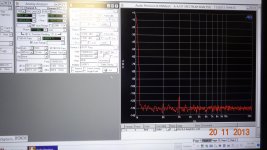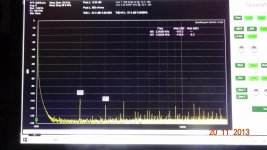I think this will illustrate what I'm asking:
The gen used was a 600 Ohm output Z (HP 339A)....
?
-RM
The point being that the QA400 etc. will introduce distortion at its input. You can measure the distortion introduced by the input of the QA400 (or whatever) with this test.
I will do that test and let everyone know if any change due to QA400 input loading and put up data here.
Thx-RNMarsh
Thx-RNMarsh
comparison A-P vs QA400
Using the ShibaSoku AG16 source (600 ohms/.7v rms), the QA400 added .0001% THD+N when applied in parallel with Audio-Precision 2722.
That is when the QA400 is in data acquisition mode... when halted and you have only the screen capture display, the THD+N is 2-3%.
The AG16 shows on the A-P as only having 2H and 3H at about -120dB and nothing above the noise floor of -135dB above those two harmonics.
The QA400 however, shows a lot of harmonics and extrainious freqs beyond the first two harmonics and shows the 2H and 3h at a higher level than the A-P.
RNM
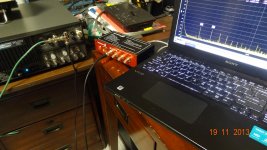
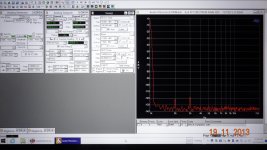
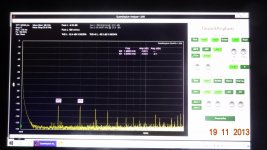
Using the ShibaSoku AG16 source (600 ohms/.7v rms), the QA400 added .0001% THD+N when applied in parallel with Audio-Precision 2722.
That is when the QA400 is in data acquisition mode... when halted and you have only the screen capture display, the THD+N is 2-3%.
The AG16 shows on the A-P as only having 2H and 3H at about -120dB and nothing above the noise floor of -135dB above those two harmonics.
The QA400 however, shows a lot of harmonics and extrainious freqs beyond the first two harmonics and shows the 2H and 3h at a higher level than the A-P.
RNM



Last edited:
If the "stock" '400 input and output stages may be the "weak link" in an otherwise excellent product, how about adapting/modifying the outboard I/O stage that Demian has already developed to "tap into and replace" the stock I/O amps?
Charles
Charles
It may be enough to make sure the QA400 input is driven from a very low impedance, i.e. a buffer.
Many opamps show somewhat nonlinear input impedance and that may become a factor at the very low distortion levels we are looking at here.
Possible Demian's interface is better in this respect?
Jan
Many opamps show somewhat nonlinear input impedance and that may become a factor at the very low distortion levels we are looking at here.
Possible Demian's interface is better in this respect?
Jan
I suspect the ESI chip and possibly the input blocking capacitor. it would be interesting to see
what we have with these parts removed or replaced.
what we have with these parts removed or replaced.
I saw the input induced distortion as well. The interface reduces it but has a similar problem of its own. However the interface does reduce the extraneous spurs.
Adding a buffer/driver to replace the one on the board could work but its still more stuff to deal with. That only makes sense when the interface is inside the box. Connecting flying leads to holes vacated by the BNC connectors is easy. Flying wired to pads on surface mount PCB's demands an additional level of skill. Also, ideal would be an integrated diff in to diff out solution like the one I'm using. Otherwise it will need a number of .1% resistors to have decent common mode rejection.
Adding a buffer/driver to replace the one on the board could work but its still more stuff to deal with. That only makes sense when the interface is inside the box. Connecting flying leads to holes vacated by the BNC connectors is easy. Flying wired to pads on surface mount PCB's demands an additional level of skill. Also, ideal would be an integrated diff in to diff out solution like the one I'm using. Otherwise it will need a number of .1% resistors to have decent common mode rejection.
FYI - there is a new '400 software version
1.061 in "preview release". Anyone tried it out? Differences?
Charles
1.061 in "preview release". Anyone tried it out? Differences?
Charles
David, what is this ESI chip - is it the input opamp/buffer or what?
jan
Sorry ESD (electrostatic discharge). It's there for protection. There is a resistor in series with the blocking capacitor and then the ESD. I think they are just a pair of diodes.
I don't why QA put this in. The op amps already have this.
The point being that the QA400 etc. will introduce distortion at its input. You can measure the distortion introduced by the input of the QA400 (or whatever) with this test.
This is interesting. It suggests that one might want to precede the QA400 with a buffer that provides it with a low-Z source impedance. Of course, while doing this one might as well build in an attenuator/protection interface for measuring power amplifiers.
This also makes me wonder what kind of circuitry there is in the QA400 input circuit.
Cheers,
Bob
At the distortion levels we are looking at buffering definitely helps. The THAT 1200 seems to work well for this but it also seems to have a nonlinear input impedance. I think there may be more to this than we have been acknowledging.
There is a number of interesting op amps designed for low voltage single ended supply with pretty impressive spects. I haven't given them much attention because I like to operate with split supplies at higher voltages. More of these op amps come to market each year with the need for low voltage battery operation. I'll bet there is a much better op amp for the QA400 from this line.
yes there is.
🙂😎
When you measure a 'system' you see things like this... cant see interfacing/interactions by measuring one component at a time individually apart from one-another.
One reason to get the A-P was to be able to do more complex measurements - like multi-tone tests - thru complete systems. I brought this up last year on another forum (JC's). It is the complete system that we hear but don't measure that way.
Thx-RNMarsh
🙂😎
When you measure a 'system' you see things like this... cant see interfacing/interactions by measuring one component at a time individually apart from one-another.
One reason to get the A-P was to be able to do more complex measurements - like multi-tone tests - thru complete systems. I brought this up last year on another forum (JC's). It is the complete system that we hear but don't measure that way.
Thx-RNMarsh
Last edited:
idea -- ... replace existing low voltage op-amps that are used now with best opamp and run them off another supply at +/- 12vdc.
[Then put protection to prevent over-driving the ADC and smoking it.]
-RNM
[Then put protection to prevent over-driving the ADC and smoking it.]
-RNM
Good idea but I think the effort would be better spent on a higher performance ADC. I'm meeting with AKM next week and will try to get details on their new ADC. The QA400 is more than adequate for most tasks and overcoming things like the grounding etc. will be the easy improvements.
If you are still set up try changing the source Z (on the AP's generator) driving the analyzer and the QA400 to see if lower source impedance helps. On my setup using the 50 Ohm and 600 Ohm source in the KH4400 I did see a significant difference. I need the effect verified before I get involved with addressing it. Then I need to work over the interface board for the same issues.
If you are still set up try changing the source Z (on the AP's generator) driving the analyzer and the QA400 to see if lower source impedance helps. On my setup using the 50 Ohm and 600 Ohm source in the KH4400 I did see a significant difference. I need the effect verified before I get involved with addressing it. Then I need to work over the interface board for the same issues.
hah! I already did it and am just now uploading ---- 50 ohm source and QA400 -- its all over the map. Not reliable/accurate under -100 (maybe not even that).
-RNM
-RNM
- Home
- Design & Build
- Equipment & Tools
- QuantAsylum QA400 and QA401

